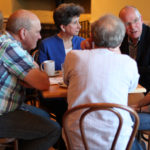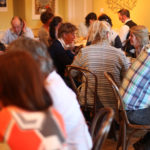
The ninth of May was a gorgeous spring evening, ‘exam weather’ as we call it in Scotland, and who could have expected over fifty people would come to a café to talk about death?
Organised to mark the start of Death Awareness Week 2016, our death café at Designs Gallery and Cafe was hosted by local Castle Douglas residents Lesley Ballantine and Iain Howie. Iain is Regional Ambassador for Age Scotland in Dumfries and Galloway.
Iain and Lesley had attended our most recent death café at Thomas Tosh in the village of Thornhill. Lesley told us that she’d been thinking of organising a death café herself.
They suggested we work together to organise a death café in Castle Douglas, a town some 30 miles further south and to the west of Dumfries.
Lesley said she became aware of the death cafe movement after suffering three very close bereavements within a short space of time. When, in late 2014, her husband was given a terminal diagnosis they both found it hard to discuss many issues around his imminent death.
Iain has hosted ‘Afore Ye Go’ events in the past, with a focus on financial matters relating to the end of life, but he said he’d become aware of a desire for more practical information surrounding death and dying.
We were keen to be involved as we would like to see more death cafés appear in the Dumfries and Galloway region, the area in which the University of Glasgow has a school on the Crichton Campus, where our Wellcome Trust-funded Global Interventions at the End of Life project is based.
Our plan is to do some academic research into the rise in popularity of the death café, with this work due to start in late 2016. In the meantime we’ve been organising and attending death cafés across Scotland to get a feel for what they are and how they function.
We’re also hoping these death cafés will help us to get in touch with local communities, giving people an opportunity to talk about death, dying, grief, bereavement and related subjects.
Iain and Lesley’s local connections were very helpful in many ways, from finding the right venue spreading the word and encouraging people to come along. We’ve learned that paper posters and leaflets, as well as announcements in the local printed press, are more likely to result in people turning up at an event than any online activities. Our team administrator Rachel spent a very worthwhile morning delivering leaflets in Castle Douglas and the surrounding areas.
As a piece of ‘public engagement’, this death café was a very interesting event, and not without challenges. We were keen not to cross the line between a public activity for the common good, and research or PR.
We were very glad to have Iain and Lesley as hosts introduce the evening. As familiar faces they made sure everyone felt welcome and had an idea of what to expect, without the event’s purpose becoming confused with interest in details of our end of life research.
There was some confusion among some participants, a few of whom had seen our flyers with the university and Wellcome Trust logos, and had come expecting a formal talk or lecture. Academic events often invite people to ‘join a conversation’, but they seldom mean more than the ‘you listen, I speak’ type of conversation.
Soon enough, however, everyone was talking in groups. Lesley, Iain and our team (this time it was just Professor David Clark, Rachel Lucas and I) joined in some of the conversations which were in turns intense, thoughtful, informative, shocking and frankly hilarious. The cafe’s waiting staff did an excellent job of delivering hot drinks and cakes in a roomful of distracted, gesticulating people.
Iain had announced that I’d be taking photos of the event, and out of the 55 attendees only two people asked me very politely to avoid them. I’m very grateful for everyone for being so open and obliging.
The feedback we received was generally positive, with some excellent practical suggestions about how to create a better format for the evening. One participant had attended one at which each table had an assigned topic for discussion – an excellent idea. We’re keen to stick to the basic outline of a death café at this stage while we learn what works and what doesn’t work, before we try different approaches as our project develops.
Other recurring feedback was that the acoustics of the wooden-floored café made it difficult for people to hear. On such a beautiful night some groups moved to the garden area to chat, but we’ll need to find a creative solution for this problem many of the galleries and cafés such as Designs have wooden floors and no carpets. A death café in a pub, next time? Or perhaps another fireside death café…
After the event Iain told me that he’d learned a lesson, in that there is a far greater appetite for this type of event than he’d envisaged. He said he was pleased to see several younger people at the death café, and that he’d noticed a high level of support from the churches. Iain had expected the turnout to be in the single figures or low teens. On such a beautiful sunny night, I have to admit I thought it might be only us organisers and the Designs staff present.
Lesley said she was “overwhelmed” by the turnout, and that she’d like this event to inspire others, that she’d be “handing over the baton” to people who will organise the next death café in the area. We hope so too.
If you’re considering running a death café in Dumfries and Galloway and think our involvement could help, please do get in touch.
Catriona Forrest










